Terminase Subunits from the Pseudomonas-Phage E217
- PMID: 36007626
- PMCID: PMC10026623
- DOI: 10.1016/j.jmb.2022.167799
Terminase Subunits from the Pseudomonas-Phage E217
Abstract
Pseudomonas phages are increasingly important biomedicines for phage therapy, but little is known about how these viruses package DNA. This paper explores the terminase subunits from the Myoviridae E217, a Pseudomonas-phage used in an experimental cocktail to eradicate P. aeruginosa in vitro and in animal models. We identified the large (TerL) and small (TerS) terminase subunits in two genes ∼58 kbs away from each other in the E217 genome. TerL presents a classical two-domain architecture, consisting of an N-terminal ATPase and C-terminal nuclease domain arranged into a bean-shaped tertiary structure. A 2.05 Å crystal structure of the C-terminal domain revealed an RNase H-like fold with two magnesium ions in the nuclease active site. Mutations in TerL residues involved in magnesium coordination had a dominant-negative effect on phage growth. However, the two ions identified in the active site were too far from each other to promote two-metal-ion catalysis, suggesting a conformational change is required for nuclease activity. We also determined a 3.38 Å cryo-EM reconstruction of E217 TerS that revealed a ring-like decamer, departing from the most common nonameric quaternary structure observed thus far. E217 TerS contains both N-terminal helix-turn-helix motifs enriched in basic residues and a central channel lined with basic residues large enough to accommodate double-stranded DNA. Overexpression of TerS caused a more than a 4-fold reduction of E217 burst size, suggesting a catalytic amount of the protein is required for packaging. Together, these data expand the molecular repertoire of viral terminase subunits to Pseudomonas-phages used for phage therapy.
Keywords: Pseudomonas-phages; bacteriophage E217; large terminase; small terminase; viral genome-packaging motor.
Copyright © 2022 Elsevier Ltd. All rights reserved.
Conflict of interest statement
Declaration of interests The authors declare that they have no known competing financial interests or personal relationships that could have appeared to influence the work reported in this paper.
Figures
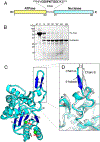
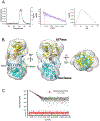
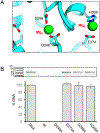

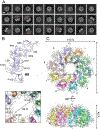

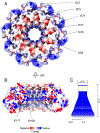
Similar articles
-
A thermophilic phage uses a small terminase protein with a fixed helix-turn-helix geometry.J Biol Chem. 2020 Mar 20;295(12):3783-3793. doi: 10.1074/jbc.RA119.012224. Epub 2020 Feb 3. J Biol Chem. 2020. PMID: 32014998 Free PMC article.
-
Biophysical analysis of Pseudomonas-phage PaP3 small terminase suggests a mechanism for sequence-specific DNA-binding by lateral interdigitation.Nucleic Acids Res. 2020 Nov 18;48(20):11721-11736. doi: 10.1093/nar/gkaa866. Nucleic Acids Res. 2020. PMID: 33125059 Free PMC article.
-
Strategies for purification of the bacteriophage HK97 small and large terminase subunits that yield pure and homogeneous samples that are functional.Protein Expr Purif. 2019 Aug;160:45-55. doi: 10.1016/j.pep.2019.03.017. Epub 2019 Apr 4. Protein Expr Purif. 2019. PMID: 30954531
-
Viral Small Terminase: A Divergent Structural Framework for a Conserved Biological Function.Viruses. 2022 Oct 8;14(10):2215. doi: 10.3390/v14102215. Viruses. 2022. PMID: 36298770 Free PMC article. Review.
-
Mechanisms of DNA Packaging by Large Double-Stranded DNA Viruses.Annu Rev Virol. 2015 Nov;2(1):351-78. doi: 10.1146/annurev-virology-100114-055212. Epub 2015 Sep 10. Annu Rev Virol. 2015. PMID: 26958920 Free PMC article. Review.
Cited by
-
Cryo-EM analysis of Pseudomonas phage Pa193 structural components.Commun Biol. 2024 Oct 6;7(1):1275. doi: 10.1038/s42003-024-06985-x. Commun Biol. 2024. PMID: 39370451 Free PMC article.
-
Structural basis for DNA recognition by a viral genome-packaging machine.Proc Natl Acad Sci U S A. 2024 Aug 13;121(33):e2406138121. doi: 10.1073/pnas.2406138121. Epub 2024 Aug 8. Proc Natl Acad Sci U S A. 2024. PMID: 39116131 Free PMC article.
-
Xanthomonas Phage PBR31: Classifying the Unclassifiable.Viruses. 2024 Mar 6;16(3):406. doi: 10.3390/v16030406. Viruses. 2024. PMID: 38543771 Free PMC article.
-
Characterization of mRNA Lipid Nanoparticles by Electron Density Mapping Reconstruction: X-ray Scattering with Density from Solution Scattering (DENSS) Algorithm.Pharm Res. 2024 Mar;41(3):501-512. doi: 10.1007/s11095-024-03671-9. Epub 2024 Feb 7. Pharm Res. 2024. PMID: 38326530
-
Cryo-EM analysis of Pseudomonas phage Pa193 structural components.Res Sq [Preprint]. 2024 Apr 12:rs.3.rs-4189479. doi: 10.21203/rs.3.rs-4189479/v1. Res Sq. 2024. Update in: Commun Biol. 2024 Oct 6;7(1):1275. doi: 10.1038/s42003-024-06985-x. PMID: 38659960 Free PMC article. Updated. Preprint.

